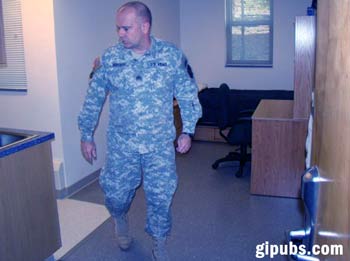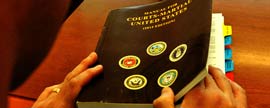The third article in the inspection series covers techniques and guidelines for conducting barracks inspections. Frequent barracks inspections provide leaders the ability to monitor the health and welfare of their Soldiers. Many Soldiers feel this inspection is unfair as they are subject to more inspections than the Soldiers who live off-post or in post quarters. To some degree this is understandable but Soldiers must also understand that unit leadership is directly responsible for helping to maintain the barracks and therefore must actively check the barrack to ensure proper maintenance is being conducted and that Soldiers are taking care of the barracks.
Click to read Part 1 of this series: U.S. Army Inspections: The Basics
Click to read Part 2 of this series: U.S. Army Inspections: Planning & Preparation
Squad leaders should be checking the barrack on an informal basis 2-3 times a week. The platoon sergeant should be conducting an informal check weekly along with the First Sergeant. These checks should include spot checking rooms for cleanliness/neatness, physical security compliance, equipment failures, and maintenance issues.

Barracks equipment should receive prompt maintenance after a problem is reported. If you expect to have your Soldiers to keep their environment to standard, you must help them resolve the problems that are outside of their control.
One of the chief complaints I have heard from Soldiers is about unsatisfactory maintenance in the barracks. Soldiers find it can take days to resolve equipment problems such as failing air conditioners or heaters after they report them. Leaders must make fixing issues in the barrack a priority as it has a direct bearing on the health, welfare, and morale of the Soldiers living in the barracks. There is nothing more frustrating than being inspected on a frequent basis and reporting equipment problems only to have them ignored and being forced to live in an environment that is not up to standard. It is contradictory. The command must push barrack issues up the chain to get prompt repairs and resolve issues quickly.
If a formal inspection is to be conducted the unit will provide specific requirements about how to lay out equipment and prepare the room for an inspection. Guidelines for barrack inspections can be found in FM 3-21.5 and unit policy.
Entry into the Barracks
As the leader enters the barracks they should check for any signs of equipment failure and inspect common areas. If common areas are not to standard they should look for the common area cleanup roster. This clean up roster should be readily visible and available to any Soldier living in the barracks. Some inspection points may for common areas could include:
- Is the floor clean and properly maintained? If not, do the Soldiers have the proper supplies and resources to do the job correctly?
- Are vending machines in good working order?
- Are there any indications that vending machines are being abused?
- Is there any evidence to suggest that barrack areas are being abused or not properly cared for?
WAR STORY
While inspecting a common area during a platoon barrack inspection, I noticed several small pieces of brown beer bottle glass in the cracks of the tile floor along the wall. It seemed a little strange, so I discussed it with the squad leaders and we continued the inspection. Later in the inspection I noticed a softball in a Soldier’s room that appeared rather banged up (cut up to be exact). The Soldier and I talked about the ball a little and then I noticed a small piece of brown glass in the ball. I asked the Soldier if he knew how the glass got there and the Soldier said he had no idea. I found this interesting. Later that night while on post I decided to stop by the barracks to check things out. As I entered the common area there was a large group of Soldier drinking and having a great time bowling with a softball and using beer bottles for pins. Oh, the Soldier who “had no idea” was about to bowl when I came in. Soldiers will be Soldiers but my point is: I saw some indicators and decided to follow up on them. All leaders must be on the look out for indicators “good or bad.” We cannot ignore them or we set our Soldiers and unit up for failure. By the way, the Soldiers enjoyed some great corrective training after this issue.

Before entering a barracks, you should develop a checklist to ensure you cover the essentials during every inspection.
Room Inspections
Once all common areas are inspected begin inspecting rooms. Before you enter the room check to ensure the door is properly marked in accordance with unit policy and then examine the door for any sign of abuse or wear.
Check the common areas of the room such as the bathroom, cabinets, etc. Any deficiencies in the room should be annotated on a sheet of paper that stays in the room. This paper should contain all deficiencies and the status of any work orders that were submitted. Work orders over one week old should be reviewed with senior members of the unit in an attempt to seek resolution. While inspecting common areas you should be alert for any unusual smells that could indicate faulty plumbing, mildew, drug or alcohol use, etc.
Then proceed to check each Soldier’s area. Check the layout for appearance, completeness, and to ensure it is in accordance with unit policy.
All equipment should be checked for cleanliness and serviceability. When checking the Soldier’s wall locker look for unusual signs like worn out undergarments or a locker that appears to be only for display. These could be indicators of other issues. For example, a Soldier could be staying off post without authorization or experiencing financial problems that make it difficult for him to purchase clothing requirements.
Depending on how much time you have you may wish to pick a few things to check in each Soldier’s area and then check the same equipment on every Soldier only deviating when you see negative indicators that give you cause to check something else out. This method ensures each Soldier get the same amount of attention and is treated the same. If you try to do a 100% inspection, some Soldiers may not get inspected at all. Just make sure you have a plan. The last thing you want is a Soldier to work hard preparing for an inspection only to not be inspected at all. This can quickly hurt morale.
While inspecting personal areas look for any indication of unauthorized equipment, illicit drugs, expired prescriptions, prescriptions with other individual’s names, weapons, etc. If you find any illegal activity you should immediately secure the area and notify senior leaders.
The same procedures can be used when conducting a health and welfare inspection. These inspections usually require coordination with military police for drug dogs or other assets. If you use dogs in your search ensure the dog handlers use common courtesy when allowing the dogs to inspect the area.
WAR STORY
During an inspection, one of the drug dogs made a mess in a Soldier’s room and the MP began laughing. We made the MP clean it up. Needless to say he stopped laughing but this incident was not a positive one for the Soldier in the room. He felt as if his home had been invaded, his privacy breached, and to top it off the MP found it all humorous. While there is nothing that can be done about the first two issues other than explaining the necessity for the inspection, the command could have had a discussion with the MP prior to the inspection about professionalism and how the inspection would be conducted. Bottom line if you bring in external agencies for an inspection lay down the ground rules and ensure they treat your Soldiers with dignity and respect.
Once you have completed the inspection of the room you should review the deficiencies and exceptional performances with the Soldiers and come up with a plan of action to correct the deficient areas.
If you run into a room that is extremely filthy it raises a few questions:
- Has the first line leader been checking this room?
- If he has, why is it this way?
- If they have not been inspecting, why not?
- Why does the Soldier believe this is an acceptable standard to live with?
- Does the Soldier realize that his poor health habits could adversely affect others?
You must develop a plan of action to correct the substandard performance on the Soldier’s part and the leader’s failure to ensure the Soldier maintains a standard. The key to effective billet inspections is to treat your Soldiers with respect and dignity. Treat them as you would want to be treated.
Read The Trainer: A Training Guide for all ranks for more information about Army Training techniques, tactics, and procedures including training best practices and example scenarios.















Comments
Kyle saccco
Hey mark, studying for the board and looking to see where I can find the Bs policy other than CQ desk and saw you said FM 3-21.5 but that covers DNC. Am I missing it in the manual?
Mark Gerecht
My apologies for the delayed response. D and C is quoted because it outlines how to prepare and element for inspections. DA PAM 670-1 and AR 670-1 should give you everything you need to know about wearing the Class B uniform. MentorMilitary.com also has a book called Army Wear It Right Uniform Book that might be of use. Here is the link:
https://www.mentormilitary.com/wear-it-right-us-army-uniform-quick-reference-book-p/mtr-wir-army.htm
On another note please stop by our YOUTUBE CHANNEL Mentor Military as it has tons of information on these type subjects and much more. If you like what you see please subscribe and tell your network. Respectfully TOP! Hope this helps
Anonymous
Can a nco force you to open your closet if it is lock and what is the AR REGUATION
Mark Gerecht
My apologies for the delayed response. Generally no, inspections cannot be used to conduct searches. Consider chatting with your local JAG, IG, and MPS on this matter. They can give you the specific regulations and how they must be used. On another note please stop by our YOUTUBE CHANNEL Mentor Military as it has tons of information on these type subjects and much more. If you like what you see please subscribe and tell your network. Respectfully TOP!
Mike
Can an NCO go through a soldiers room without the soldier being present?
Mark Gerecht
Please see the following post: http://asktop.net/q-and-a/can-the-chain-of-command-conduct-barracks-inspections-without-soldiers-being-present/